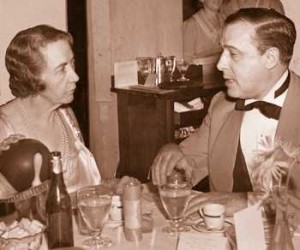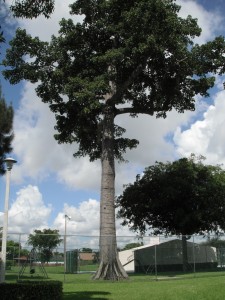You may have driven on Summit Boulevard, just west of Military Trail, and seen the Summit Pines development. Another nicely manicured collection of homes and condominiums. But it has a secret. It was once a grand estate which probably had no equal in Palm Beach county – a gentleman’s country home, complete with flower gardens, a dairy and greenhouses with exotic plants.
You probably have never heard of Hugh Dillman. He was born in 1885 in Ohio under the name Hugh Dillman McGaughey, and made his way to the Broadway stage. He also had a brief silent movie film career, making a few movies such as “Am Amateur Widow.” He left his acting career to join the Navy in 1917 and served in World War I. In 1919, he married a very popular actress of the time, Marjorie Rambeau. The marriage did not last and the couple were divorced in 1923. Friends had told him of Palm Beach and the opportunities it offered, with the land boom just gearing up. He came to Palm Beach and began to sell real estate and was one of the founding members of the Society of Arts (later renamed the Society of the Four Arts) and served as its first chairman. Mr. Dillman was also interested in music, and had arranged a tour for a group of young African-American singers throughout Europe. It was on that tour that he met Anna Thompson Dodge, the middle-aged widow of Horace Elgin Dodge, the car magnate. Anna Dodge was reportedly the richest woman in the world at that time, having lost her husband fairly early in life.
Dodge was very taken with Mr. Dillman and asked him to find her a house in Palm Beach. He was her sales agent on the largest house in Palm Beach, Addison Mizner’s Palm Beach masterpiece, Playa Riente (“Laughing Beach”). Dodge bought Playa Riente in 1926 from Joshua Cosden, a wealthy Oklahoma oilman who had lost his fortune in horse racing. Dillman and Dodge were married May 8, 1926 in her Michigan mansion, with Dillman being fourteen years her junior. While on one of their many trips around the world, Dillman decided he wanted his own country farm. Dillman was raised on a farm, and believed that small family farms were a way that the common man could support a family. in 1931, he cabled a friend while in Calcutta, India to purchase land for him in Palm Beach County. He returned in the fall to find his land under ankle-deep water! He purchased adjacent land tracts so that the farm was about 400 acres and drained the land.
He named the estate “Sandy Loam Farm” and wanted to create an experimental agricultural farm to see what kinds of produce and plants could be grown in South Florida. He built a very large log cabin-style lodge that was expanded with additional quarters in the 1930s.
A search of the Palm Beach Post historic archives revealed countless mentions of the parties and events that were held at Sandy Loam, many with over 100 guests. The events included concerts, luncheons, dances, and fund raisers. Guests entered the estate down a beautiful tree-lined driveway,
visible in the adjacent photograph. During the Great Depression, Dillman raised thousands of chickens that were sold for 25 cents, or donated to the Salvation Army. Sandy Loam also had a working dairy with Jersey cows and Black Angus beef cattle.
Dillman was truly at the center of Palm Beach society. He served as president of the exclusive Everglades Club from 1936 to 1951, and saved the club from bankruptcy with his “Victory Dinner” where over $600,000 was raised. It is believed to be the biggest event ever held at the club and featured the Ziegfeld Follies. Mr. Dillman was also very active in fund-raising during World War II, hosting many events to help soldiers and refugees in Europe. He also was instrumental in fund raising for Good Samaritan Hospital, and the Hugh Dillman Pavilion was named in his honor.
In 1943, Dillman sold the Sandy Loam Farm to to three couples. Apparently the commute from Sandy Loam to the Everglades Club was too far during WWII, so he took an apartment at the Everglades Club. This also was an indication that his marriage to Anna Dodge was in trouble. She filed for divorce in March 1947, citing the fact that they had not lived together for seven years.
Sandy Loam was sold again in 1946, this time to S.R. Famel, for $125,000. The Famels turned Sandy Loam into a commercial nursery specializing in flowers and all kinds of tropical plants. Ads from the 1950s give the address as “Dillman Road”. The road was eventually renamed Summit Boulevard to where Summit terminates at Jog Road. There, Dillman Road does carry west to Okeeheelee Park and then west past the turnpike.
Dillman resigned as president of the Everglades Club in 1951, citing declining health. He lived in Canada for many years, but returned to Ohio to live with his sister in Columbus, Ohio where he died in 1956 at the age of 71. Anna Dodge stayed a while in Palm Beach. She wanted to turn Playa Riente into a school or club, but the Palm Beach City Council did not approve the zoning change. She sued and lost in court. She held a large estate sale and then had the mansion demolished in 1958, a tragic loss. Anna returned to her Michigan estate and died at the age of 99 in 1971
The Famels owned Sandy Loam Farm until the 1980s. In March of 1984, an estate sale was held and the fixtures and contents of Sandy Loam Farm and the lodge were sold at auction, and the buildings torn down. Sadly, I was not able to locate a picture of the log home. Could anything from that time have survived? I looked at aerial photos from today and 1968, and knew that the lodge stood exactly where the clubhouse and tennis courts in the Summit Pines development are today. As I rounded the bend, I saw it. A survivor. A beautiful 75 foot-tall kapok tree! A resident was retrieving mail at the clubhouse, and indicated that there were once three kapok trees, but two had been lost during the 2004/2005 hurricanes.
I spoke with a man who has worked on the property for 18 years, and he had no idea about the history, but had wondered about the large tree. He also pointed out the row of Royal Palms lining the lake. He said every year people come and collect the seeds as they are a smaller, more elegant variety than the common Royal Palm. By looking at pictures of different types of Royal Palms, I think they might be Puerto Rican Royal Palms. My research revealed that Gene Joyner, the retired county horticulturist, worked on the Sandy Loam Farm during college, so I will follow-up with him to see if I can find a photograph of the log cabin lodge.
Dillman was truly a renaissance man. I think he probably would like to best be remembered as a gentleman farmer. A quote from a November 28, 1941 article from the Palm Beach Post says it best: “He loves every one of those trees and shrubs, many of which he planted by hand; every log in the cabin, built from the trees that had to be cleared from the land. If Mr. Dillman has anything to say about it, there will always be a Sandy Loam.”
This story was researched through the Palm Beach Post Historic Archives and the New York Times Archives.









WOW! What is now a large neighborhood used to be a big farm. So this farm was active into the 1980’s?Looking at aerials from 1968 and 1979 (historicaerials.com) there seems little agricultural activity on the south side. Also, I see in the aerials from 1953 that Forest Hill Blvd ended at Military, so it went through the farm when it got expanded in 1957? Finally, what other current neighborhoods stand today where Sandy Loam Farms once stood? Is Palm Hill Villas and Abbey Park Gardens on former Sandy Loam Land? Great Article!, looking forward to read more about Sandy Loam Farms.
[WORDPRESS HASHCASH] The poster sent us ‘0 which is not a hashcash value.
Anna Dodge was well familiar with Palm Beach, and Palm Beach real estate, long before she met Hugh Dillman. Anna was a good friend of Eva Stotesbury, the society “queen” of Palm Beach during the 1920s and 1930s. Eva and her husband, E.T. Stotesbury, hired Addison Mizner to build the “El Mirasol” estate, in 1919. Anna and Eva were connected by marriage, as Anna’s only daughter (Delphine Ione Dodge) met Eva’s youngest son (James H.R. Cromwell) when both were staying with their respective families in Palm Beach, in March 1920. Jimmy and Delphine were married (in Detroit) in June 1920, and spent a considerable amount of time on the El Mirasol estate during the early 1920s, and doubtless Anna would have also visited.